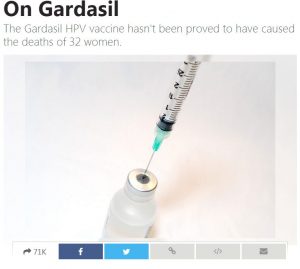What Is Madeup Funny Blog People Believe
False Information v Fake News
Experts now recommend avoiding the term 'fake news', or at least limit its use, as the term 'fake news' is closely associated with politics, and this association can unhelpfully narrow the focus of the issue. The term 'false information' is preferable as it can refer to a diverse range of disinformation covering topics such as health, environmental and economics across all platforms and genres, while 'fake news' is more narrowly understood as political news stories.
What is False Information?
Lots of things you read online especially in your social media feeds may appear to be true, often is not. False information is news, stories or hoaxes created to deliberately misinform or deceive readers. Usually, these stories are created to either influence people's views, push a political agenda or cause confusion and can often be a profitable business for online publishers. False information can deceive people by looking like trusted websites or using similar names and web addresses to reputable news organisations.
According to Martina Chapman (Media Literacy Expert), there are three elements to fake news; 'Mistrust, misinformation and manipulation'.
The Rise of False Information
False information is not new, however it has become a hot topic since 2017. Traditionally we got our news from trusted sources, journalists and media outlets that are required to follow strict codes of practice. However, the internet has enabled a whole new way to publish, share and consume information and news with very little regulation or editorial standards.
Many people now get news from social media sites and networks and often it can be difficult to tell whether stories are credible or not. Information overload and a general lack of understanding about how the internet works by people has also contributed to an increase in fake news or hoax stories. Social media sites can play a big part in increasing the reach of these type of stories.
The economics of social media favour gossip, novelty, speed and "shareability"' Simeon Yates
Types of False Information
There are differing opinions when it comes to identifying types of false information. However, when it comes to evaluating content online there are various types of false or misleading news we need to be aware of. These include:
1. Clickbait
These are stories that are deliberately fabricated to gain more website visitors and increase advertising revenue for websites. Clickbait stories use sensationalist headlines to grab attention and drive click-throughs to the publisher website, normally at the expense of truth or accuracy.

2. Propaganda
Stories that are created to deliberately mislead audiences, promote a biased point of view or particular political cause or agenda.

3. Satire/Parody
Lots of websites and social media accounts publish fake news stories for entertainment and parody. For example; The Onion, Waterford Whispers, The Daily Mash, etc.

4. Sloppy Journalism
Sometimes reporters or journalists may publish a story with unreliable information or without checking all of the facts which can mislead audiences. For example, during the U.S. elections, fashion retailer Urban Outfitters published an Election Day Guide, the guide contained incorrect information telling voters that they needed a 'voter registration card'. This is not required by any state in the U.S. for voting.
5. Misleading Headings
Stories that are not completely false can be distorted using misleading or sensationalist headlines. These types of news can spread quickly on social media sites where only headlines and small snippets of the full article are displayed on audience newsfeeds.

6. Biased/Slanted News
Many people are drawn to news or stories that confirm their own beliefs or biases and fake news can prey on these biases. Social media news feeds tend to display news and articles that they think we will like based on our personalised searches.

T he False Information Business Model
The internet and social media have made it very easy for anyone to publish content on a website, blog or social media profile and potentially reach large audiences. With so many people now getting news from social media sites, many content creators/publishers have used this to their advantage.
False information can be a profitable business, generating large sums of advertising revenue for publishers who create and publish stories that go viral. The more clicks a story gets, the more money online publishers make through advertising revenue and for many publishers social media is an ideal platform to share content and drive web traffic .
False Information, Social Media, and the Filter Bubble
In a recent article on media literacy, Hugh Linehan noted; "Media is no longer passively consumed – it's created, shared, liked, commented on, attacked and defended in all sorts of different ways by hundreds of millions of people. And the algorithms used by the most powerful tech companies – Google and Facebook in particular – are brilliantly designed to personalise and tailor these services to each user's profile."
When we go online or login to a social network we are generally presented with news, articles and content based on our own searches online. This type of content tends to reflect our own likes, views and beliefs and therefore isolating us from differing views and opinions. This is often referred to as a filter bubble.
What can we do about False Information?
Google and Facebook have announced new measures to tackle fake news with the introduction of reporting and flagging tools. Media organisations like the BBC and Channel 4 have also established fact checking sites While these are welcome developments, digital media literacy and developing skills to critically evaluate information are essential skills for anyone navigating the internet and especially for young people.
The vast amount of information available online and rise in fake news highlights the need for critical thinking. Children need to develop critical thinking from an early age. This is a key skill for young people to develop as they enter into third level education and prepare themselves for the workplace.
How to spot False Information?
There are a number of things to watch out for when evaluating content online.
- Take a closer look
Check the source of the story, do you recognise the website? Is it a credible/reliable source? If you are unfamiliar with the site, look in the about section or find out more information about the author.
- Look beyond the headline
Check the entire article, many fake news stories use sensationalist or shocking headlines to grab attention. Often the headlines of fake new stories are in all caps and use exclamation points.
- Check other sources
Are other reputable news/media outlets reporting on the story? Are there any sources in the story? If so, check they are reliable or if they even exist!
- Check the facts
Stories with false information often contain incorrect dates or altered timelines. It is also a good idea to check when the article was published, is it current or an old news story?
- Check your biases
Are your own views or beliefs affecting your judgement of a news feature or report?
- Is it a joke?
Satirical sites are popular online and sometimes it is not always clear whether a story is just a joke or parody… Check the website, is it known for satire or creating funny stories?
Useful Resources:
 Be Media Smart – www.bemediasmart.ie #StopThinkCheck
Be Media Smart – www.bemediasmart.ie #StopThinkCheck
Developed by Media Literacy Ireland, Be Media Smart offers useful tips and guidance on how to tell the difference between reliable and accurate information and or deliberately false or misleading information.
 Media Literacy Ireland – www.medialiteracyireland.ie
Media Literacy Ireland – www.medialiteracyireland.ie
Facilitated by the Broadcasting Authority of Ireland, MLI is a network of volunteer members coming from a large number of sectors, organisations and interests, working together to empower people to make informed media choices about the media content and services that they consume, create, and disseminate across all platforms. The MLI offers useful media literacy resources, research, and news.
Fact checking sites
Snopes: snopes.com/
PolitiFact: politifact.com
Fact Check: factcheck.org/
BBC Reality Check: bbc.com/news/reality-check
Channel 4 Fact Check: channel4.com/news/factcheck
Reverse image search from Google: google.com/reverse-image-search
Deep Fakes and Visual Deception
Deepfakes are fake videos created using digital software, machine learning and face swapping. Deepfakes are computer-created artificial videos in which images are combined to create new footage that depicts events, statements or action that never actually happened. The results can be quite convincing. Deep fakes differ from other forms of false information by being very difficult to identify as false.
Find out more in Explained: What Are Deepfakes?
Source: https://www.webwise.ie/teachers/what-is-fake-news/
0 Response to "What Is Madeup Funny Blog People Believe"
Post a Comment